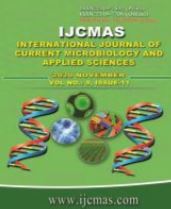


 National Academy of Agricultural Sciences (NAAS)
National Academy of Agricultural Sciences (NAAS)

|
PRINT ISSN : 2319-7692
Online ISSN : 2319-7706 Issues : 12 per year Publisher : Excellent Publishers Email : editorijcmas@gmail.com / submit@ijcmas.com Editor-in-chief: Dr.M.Prakash Index Copernicus ICV 2018: 95.39 NAAS RATING 2020: 5.38 |
Rice (Oryza sativa) occupies a prime position in the family Poaceae and it is the highly consumable crop of almost half of the world's population. Among the various diseases affecting rice, blast incited by Magnaporthe oryzae is the one of the ubiquitous and economically important disease which affects almost all the stages of crop and cause yield loss upto 50%. In the present study, survey was carried out in Nilgiri and Madurai districts of Tamil Nadu for the collection of blast isolates. The blast disease incidence ranged from 8.8 to 42.4 per cent in various rice cultivars. Fifteen isolates of Magnaporthe oryzae were isolated from symptomatic tissues and maintained in pure culture. All the 15 isolates produced greyish brown to white colour colony with a diameter which ranged from 80-90 mm in PDA medium. Sporulation was carried out by stem bit inoculation method which produced pyriform shaped conidia with the size range of 8-12 × 3.3-3.6 µm. The pathogenicity tests in cv. ASD 16 by spraying the spore suspension (1 × 106 spores/ml) revealed that, the isolate IS (Kar)-3 was more virulent followed by IS (Aru)-4 and IS (Kul)-6 which was found to be least virulent. Thus, there exists morphological and pathogenic variability among the Magnaporthe oryzae isolates within the close proximity.
 |
 |
 |
 |
 |